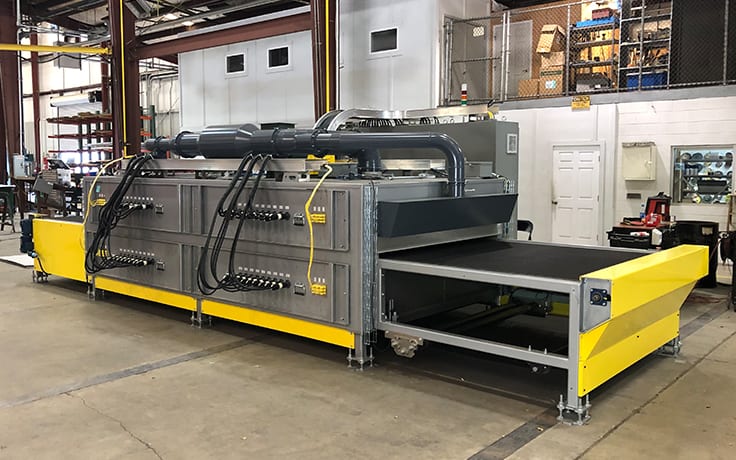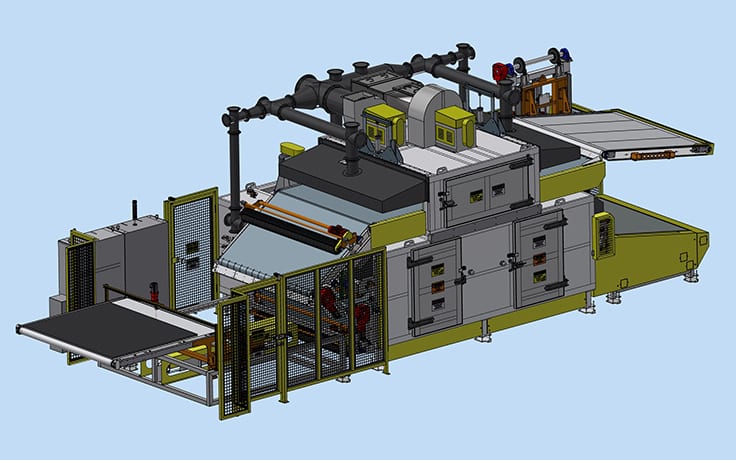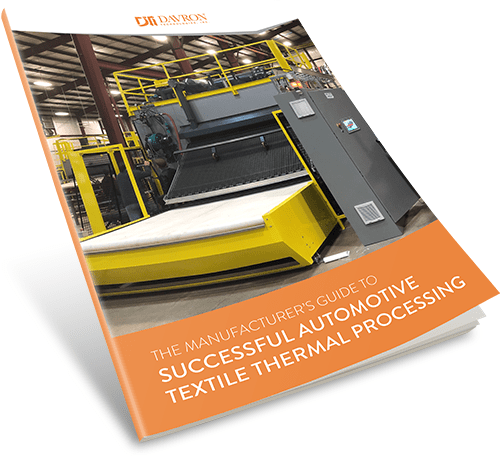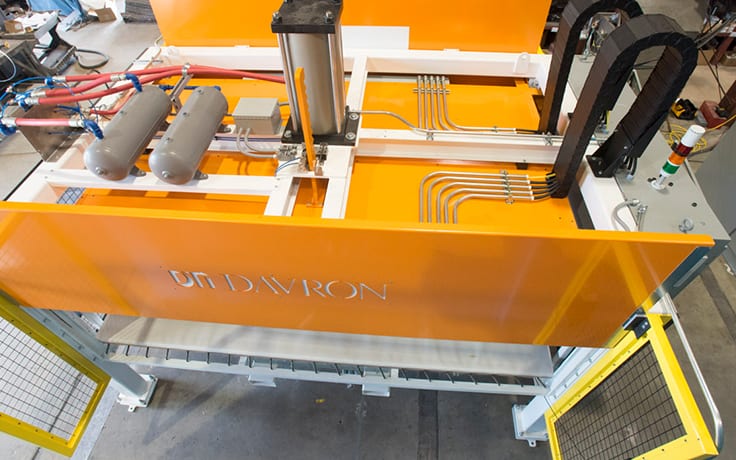When manufacturers of automotive textiles consider adding or upgrading thermal processing methods and equipment for their facility, they tend to stick with what they know works.
But there’s a big difference between the method that “works” and the one ideally suited for specific materials or manufacturing processes.
We share this discussion of infrared, radiant, convection and contact heating to help corporate engineers compare thermal processing methods and identify whether their current system is truly the best match for the products they manufacture.

Infrared (IR) thermal processing
Infrared (IR) heating occurs when electromagnetic radiation is directed at a workpiece. The name comes from the “infrared” portion of the electromagnetic spectrum, with wavelengths from 700 nm to 1 mm.
Short-wave, high-intensity IR heat is best applied to a part surface over a short period of time. Drying ink or other liquids on part surfaces or flash curing after powder coating are among the common applications of IR thermal processing.
IR is typically not suitable if a workpiece must be heated consistently through its entire cross section. Thick, dense parts or parts made of materials with low heat transfer coefficients do not respond well to this method.
Infrared thermal processing is common in automotive textile manufacturing, but it’s not always the ideal method for these products.
This is because IR energy heats surfaces very quickly but does not penetrate very far inward. Consequently, manufacturers using IR heat to prepare automotive carpeting struggle to reach the specified core temperature without roasting the surface beyond the point of destruction.
(This case study describes that exact phenomenon.)
However, IR is well-suited for adhesive-backed plastic fiber carpeting. By focusing the energy only toward the surface where the adhesive was applied (the B-side), the adhesive is activated and the carpet fibers become much more malleable. The short-wave energy never penetrates through the part, preserving the A-side finish.
Radiant heat thermal processing
Let’s clear up some nomenclature. In physics, “radiant” heat refers to electromagnetic radiation that emits from something hot.
Under that strict definition, infrared as described above is a specific type of radiant energy characterized by its electromagnetic wavelength.
So, “radiant heating” in industrial thermal processing refers broadly to electromagnetic radiation and is not confined to specific bandwidths or wavelengths.
Besides infrared heaters and lamps, the most common source of radiant heat is piping filled with steam, hot water or hot oil—just like in old homes.
Very thick parts that require much longer soak times are good candidates for radiant heating. It also works well for thermal processing of many kinds of plastics, including polycarbonates.
While radiant heating is generally rare in automotive textile manufacturing, Davron has built systems that combine radiant and IR heat to process carpets. Concentrated IR energy melts glue on the B-side while milder radiant energy warms the A-side.

Convective thermal processing
Anyone who bakes at home is familiar with convective heating, in which heat is transferred via the movement of molecules in a fluid. In the case of industrial thermal processing (as with home baking), the “fluid” is the air inside the oven.
In convection, differences in temperature among molecules cause them to move in relation to one another. This thermodynamic motion imparts heat to a workpiece.
Forced convection is a variant of this method in which fans direct heated air toward a workpiece. The way the air is directed improves the speed and uniformity of heating, providing an advantage over natural convection that’s made it popular among manufacturers.
Electric heating elements and gas-fired burners are the most common sources of heat for convection ovens. Gas ovens tend to heat faster, are more adjustable and less expensive to operate for industrial scale production. Electric ovens are better suited for inert atmosphere ovens or for processes that are sensitive to the byproducts of gas-fired burners.
Convective heating is quite versatile, stable and forgiving. Deciding whether to use it is less a matter of the characteristics of the method itself and more a matter of whether the method is viable within the broader parameters of the manufacturing process.
Thicker, denser, permeable materials or those with lower heat transfer coefficients are generally ideal for convection heating.
Forced-air convection heating is not an ideal method for adhesive-backed carpets or materials with powder adhesives applied prior to thermal processing.
In the former case, adhesive-backed carpets start out as impermeable materials but then become permeable as the adhesive melts. Unless all the adhesive melts in the same instant, “holes” will form and all the heat inside the chamber will pour through, which can cause severe damage. In the latter case, forced air ends up blowing the powder off the surface of the material before it can melt.
Convection heating systems comprise the largest share of automotive ovens we’ve built.
Bringing the heat
The manufacturer’s guide to successful automotive textile thermal processing

Contact thermal processing
Contact thermal processing is more straightforward: the transfer of heat from something that’s hot to something that’s not via direct contact.
Separate, controllable zones of electric heating elements inside aluminum platens are by far the most common setup. Aluminum’s relatively high conductivity makes it the ideal metal for contact heating.
(Copper, gold and silver all have higher thermal conductivity than aluminum. But copper is around seven times more expensive than aluminum. Gold and silver are even more monstrously costly.)

Electric contact heating is usually best because the heating elements can be oriented in programmable zones throughout a platen and dialed up or down in intensity depending on process specifications. Pumping heated oil through metal platens also works, but it’s not as easy to control the heat. Oil systems also come with a leakage risk.
Contact heat should almost never be specified for materials that include adhesives. This is because the adhesive material will stick to the platens when it melts, making a gluey mess that operators must scrape off. This risk is minimized in some cases if platens are protected by Teflon coatings, or if protective films are applied to the product prior to heating.
We’ve observed that in most cases where manufacturers use contact heating, they could replace it with convection or IR and do the job in half the time. What’s more, the utility costs associated with electric contact heating are far higher than the cost to operate gas-fired convection systems.
That said, we have built custom contact heating ovens for manufacturers whose unique process requirements meant it would be the most effective method. Examples include this contact heat/IR oven line as well as this contact heater.
Making the right call
Is obsolete automotive textile thermal processing equipment having trouble keeping up with today’s demands? Has a new model year brought new specs requiring an equipment upgrade? Is your facility taking on a wider variety of work requiring more flexible thermal processing?
Choosing the right equipment for your facility is always easier when you have a partner who understands thermal processing and can apply that knowledge to solve automotive textile manufacturing challenges.
At Davron, we understand the process, material and facility variables that factor into this decision. And, we emphasize evidence-based custom engineering to serve our ultimate purpose: determining the best heating method for your unique application.
Think we’re a good fit? Let’s talk about your facility.






